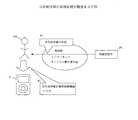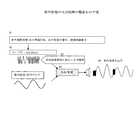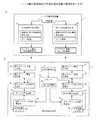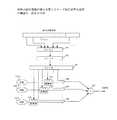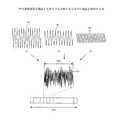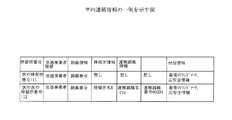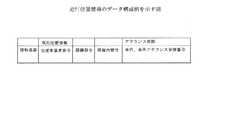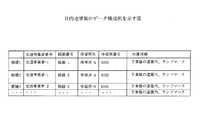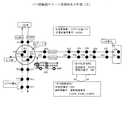JP2009205485A - Vehicle getting-on/off notification method and vehicle getting-on/off notification system - Google Patents
Vehicle getting-on/off notification method and vehicle getting-on/off notification systemDownload PDFInfo
- Publication number
- JP2009205485A JP2009205485AJP2008047806AJP2008047806AJP2009205485AJP 2009205485 AJP2009205485 AJP 2009205485AJP 2008047806 AJP2008047806 AJP 2008047806AJP 2008047806 AJP2008047806 AJP 2008047806AJP 2009205485 AJP2009205485 AJP 2009205485A
- Authority
- JP
- Japan
- Prior art keywords
- information
- vehicle
- stop
- route
- user
- Prior art date
- Legal status (The legal status is an assumption and is not a legal conclusion. Google has not performed a legal analysis and makes no representation as to the accuracy of the status listed.)
- Pending
Links
- 238000000034methodMethods0.000titleclaimsabstractdescription29
- 239000000284extractSubstances0.000claimsabstractdescription15
- 238000012546transferMethods0.000claimsdescription22
- 238000003860storageMethods0.000description25
- 238000010586diagramMethods0.000description18
- 238000004891communicationMethods0.000description13
- 230000015572biosynthetic processEffects0.000description11
- 238000003786synthesis reactionMethods0.000description11
- 238000001514detection methodMethods0.000description5
- 238000000605extractionMethods0.000description5
- 238000012545processingMethods0.000description4
- 125000002066L-histidyl groupChemical group[H]N1C([H])=NC(C([H])([H])[C@](C(=O)[*])([H])N([H])[H])=C1[H]0.000description3
- 230000001174ascending effectEffects0.000description3
- 238000004519manufacturing processMethods0.000description3
- 238000002360preparation methodMethods0.000description3
- 230000005236sound signalEffects0.000description3
- 238000013459approachMethods0.000description2
- 230000000694effectsEffects0.000description2
- 230000004308accommodationEffects0.000description1
- 238000006243chemical reactionMethods0.000description1
- 239000012141concentrateSubstances0.000description1
- 238000005516engineering processMethods0.000description1
- 238000005070samplingMethods0.000description1
- 230000002194synthesizing effectEffects0.000description1
Images
Landscapes
- Traffic Control Systems (AREA)
- Navigation (AREA)
- Circuit For Audible Band Transducer (AREA)
- Train Traffic Observation, Control, And Security (AREA)
Abstract
Description
Translated fromJapanese本発明は、乗降車通知技術に関し、特に、交通機関において運行される車両の利用者に対して乗降車に関する情報を通知する乗降車通知方法及び乗降車通知システムに関する。 The present invention relates to a boarding / alighting notification technique, and more particularly to a boarding / alighting notification method and a boarding / alighting notification system for notifying a user of a vehicle operated in a transportation facility of information related to boarding / alighting.
電車やバス等に乗車中である該電車やバス等の利用者が、利用したい場所(目的地)に該電車等が近づいた時に、目的地に近づいたことを自動的に知らせて欲しい場合がある。利用者が知らない場所に行く場合はもちろん、該利用者が知っている場所に行く場合でも、該利用者が電車やバス内で携帯情報機器を用いた音楽、ゲーム等、コンテンツの利用に集中したいときなどには、該利用者が車内アナウンスや周囲の風景に注意を払わなくても自分の利用している電車等が目的地に近づいたことを携帯端末が音や振動などで通知してくれれば、該利用者にとって便利である。また、駅やバスの停留所などにおいて電車又はバスを待っている利用者に対して、該駅、バスの停留所に到着する電車、バスが該利用者の目的地方面に行くか否か、すなわち、乗車の可否を自動で通知するシステムがあれば、該利用者にとって便利である。 When a user of a train or bus, who is on a train or bus, wants to automatically notify that he / she has approached his / her destination when the train / approach approaches his / her place (destination) is there. The user concentrates on the use of content such as music and games using portable information devices in trains and buses, not only when he / she goes to a place he / she does not know When the user wants to do so, the mobile terminal notifies the user that the train he / she is using has approached his / her destination by sound or vibration without paying attention to the announcement in the car and surrounding scenery. If it gives, it is convenient for the user. In addition, for users who are waiting for a train or bus at a station or bus stop, whether or not the train or bus arriving at the station or bus stop goes to the destination area of the user, that is, If there is a system for automatically notifying whether or not it is possible to ride, it is convenient for the user.
交通機関において運行される車両の利用者に対して該車両が該利用者の目的地に近づいたことを通知する方法として、該利用者が保持する携帯情報機器が自律的に自身の位置を検知して該車両が目的地に近づいたかを判断し、判断結果を該利用者に対して通知することが考えられる。また、例えば、車両内において該車両の位置を表す電波を出力し、利用者が保持する携帯情報機器が上記電波に基づいて該車両の位置を特定し、該車両が該利用者の目的地に近づいたことを該利用者に通知することが考えられる。
なお、入力された交通機関の駅又は停留所の発車メロディが目的地のメロディと一致するかを判断し、該判断結果に基づいて、乗客に乗り過ごさないよう通知する携帯報知装置が提案されている(例えば、特許文献1参照)。また、駅又はバス停の近傍において、各駅又は各バス停の識別情報を含む電波を送信し、電車等の利用者が携帯する降車通知装置が上記電波を受信し、該電波に含まれる識別情報と該利用者が目的とする降車駅に対応する識別情報とが一致するかを判断し、該判断結果に基づいて、該電車等が上記目的とする降車駅に接近したことを該利用者に通知する降車通知システムが提案されている(例えば、特許文献2参照)。
It is to be noted that a portable alarm device has been proposed that determines whether or not the input departure melody at a station or stop of transportation coincides with the melody at the destination and notifies passengers not to get over based on the determination result. (For example, refer to Patent Document 1). Further, in the vicinity of the station or bus stop, a radio wave including identification information of each station or each bus stop is transmitted, and a getting-off notification device carried by a user such as a train receives the radio wave, and the identification information included in the radio wave and the The user determines whether the identification information corresponding to the target disembarkation station matches, and based on the determination result, notifies the user that the train or the like has approached the target disembarkation station. A getting-off notification system has been proposed (see, for example, Patent Document 2).
車両の利用者が保持する携帯情報機器が自律的に自身の位置を検知して該車両が目的地に近づいたかを判断し、判断結果を該利用者に対して通知する上記従来技術では、該携帯情報機器の機能負担が大きいという問題がある。
また、車両内において該車両の位置を表す電波を出力し、利用者が保持する携帯情報機器が上記電波に基づいて該車両の位置を特定する技術は、該電波の医療機器使用者への影響を考慮すると制約が大きい。また、上記電波としてごく弱い電波を利用する場合、携帯情報機器を電波発信源の近くに置かねばならないので、混雑した電車/バスなど利用者が移動しづらい状況では使いづらいという問題がある。
本発明は、このような事情に鑑みなされたものであって、本発明の目的は、交通機関において運行される車両の乗降車に関する情報が重畳された音声情報に基づいて該車両の利用者に対して乗降車の可否を通知する乗降車通知方法及び乗降車通知システムを提供することである。In the above prior art in which the portable information device held by the user of the vehicle autonomously detects its own position to determine whether the vehicle has approached the destination, and notifies the user of the determination result, There is a problem that the functional burden of the portable information device is large.
In addition, a technology for outputting a radio wave representing the position of the vehicle in the vehicle and for the portable information device held by the user to identify the position of the vehicle based on the radio wave has an effect on the medical device user of the radio wave. Considering this, the restrictions are large. In addition, when a very weak radio wave is used as the radio wave, the portable information device has to be placed near the radio wave source, which is difficult to use in situations where it is difficult for a user such as a crowded train / bus to move.
The present invention has been made in view of such circumstances, and an object of the present invention is to provide a user of the vehicle based on voice information on which information related to getting on and off of the vehicle operated in transportation is superimposed. It is intended to provide a boarding / alighting notification method and a boarding / alighting notification system for notifying whether or not boarding / alighting is possible.
以下に、本発明の概要について説明する。まず、図1に示すように、交通機関において運行される車両の利用者400が保持する携帯情報機器3が、公共施設(例えば、病院)、商業施設などの情報提供者401から目的地情報を取得し(図1の#1を参照)、取得した目的地情報を入力する(図1の#2を参照)。目的地情報は、利用者400の目的地と、該目的地を通る、交通機関の路線の情報である。例えば、携帯情報機器3は、利用者400の指定入力に従って、目的地情報を保持している情報提供者401のサイトからインターネットを通じて目的地情報をダウンロードする。携帯情報機器3は、施設のインフォメーションコーナ−、ターミナル駅の案内板、観光パンフレット、バス停等に表示されているQRコードを読み込んで、該QRコードが示す目的地情報を取得するようにしてもよい。また、利用者400が電話網を通じて情報提供者401から目的地情報を取得し、携帯情報機器3が、該利用者400の指定入力に従って、該目的地情報を入力するようにしてもよい。 The outline of the present invention will be described below. First, as shown in FIG. 1, a
次に、図2に示すように、携帯情報機器3が、入力された目的地情報が示す目的地(図2に示す例では、○○病院)までの経路の候補を表示して、利用者400に目的地情報の入力内容を確認及び選択させる。そして、携帯情報機器3が、該利用者400の指定入力に従って、選択内容を登録する。
次に、車両又は車外の所定の施設(例えば、停留所、駅等)に設けられる乗降車通知装置(図7を参照して後述)が、車両が停留所又は駅に到着してから発車するまでの間に、車外で、少なくとも該車両の路線に関する情報が重畳された音声情報を車外情報として出力する。すなわち、図3に示すように、まず、該車両又はコード情報を作成する所定の装置(図7を参照して後述するコード情報作成装置)が、交通事業者番号、該車両の路線番号、停留所番号、該車両が今後連絡する路線(連絡路線)の路線番号がコード化された情報(利用判別情報)を作成する(図3の#1,#2を参照)。そして、乗降車通知装置が、該利用判別情報に対応した可聴音を生成する(図3の#3を参照)。そして、該乗降車通知装置が、上記生成された可聴音を車両の案内放送(車外アナウンス)に重畳(合成/変調)させて(図3の#4を参照)、車外情報を生成し、出力する(図3の#5を参照)。例えば、図4に示すように、バス402(が備える乗降車通知装置)が、該バス402が停留所403に到着してから発車するまでの間に、利用判別情報(例えば、バス会社名、該バス402の路線番号、現在の停留所の停留所番号、該バス402が今後連絡する連絡路線の連絡路線番号)を案内放送(図4に示す例では、「このバスは◎□経由 山22系 □▽団地行きです」という案内放送)に重畳させて車外情報として出力する(図4の#1を参照)。
停留所等にいる利用者が保持する携帯情報機器3は、上記車外情報を受信し、該車外情報に重畳された利用判別情報を抽出し、該利用判別情報と携帯情報機器3に入力された目的地情報とを比較し、比較結果に基づいて、乗車の可否(乗車すべきであるか否か)を判断し、判断結果を画面表示する(図4の#2を参照)。利用者400は、携帯情報機器3が画面表示した情報を参照することで、停留所等に到着した車両が自分の目的地に到着できるか否か(乗車すべきか否か)を知ることができる。Next, as shown in FIG. 2, the
Next, a boarding / alighting notification device (described later with reference to FIG. 7) provided in a vehicle or a predetermined facility outside the vehicle (for example, a stop, a station, etc.) until the vehicle departs after it arrives at the stop or the station. In the meantime, outside the vehicle, audio information on which at least information related to the route of the vehicle is superimposed is output as the outside information. That is, as shown in FIG. 3, first, a predetermined device for creating the vehicle or code information (a code information creation device described later with reference to FIG. 7) has a traffic operator number, a route number of the vehicle, a stop Information (use discrimination information) in which the number and the route number of the route that the vehicle will contact in the future (connection route) is encoded (see # 1 and # 2 in FIG. 3). Then, the boarding / alighting notification device generates an audible sound corresponding to the use determination information (see # 3 in FIG. 3). Then, the boarding / alighting notification device superimposes (synthesizes / modulates) the generated audible sound on the vehicle guidance broadcast (announcement outside the vehicle) (see # 4 in FIG. 3) to generate outside information and output it. (See # 5 in FIG. 3). For example, as shown in FIG. 4, the use determination information (for example, the name of the bus company, the The route number of the
The
また、本発明は、停留所又は駅に停車する前に、車内で、少なくとも該停留所又は駅を識別する情報が重畳された音声情報を車内情報として出力する。すなわち、図5に示すように、該車両又はコード情報を作成する所定の装置が、次の停留所の停留所名、次の停留所の停留所番号、上記停留所において連絡する連絡路線の連絡路線番号がコード化された情報(車内連絡情報)を生成する(図5の#1,#2を参照)。そして、上記乗降車通知装置が、車内連絡情報に対応した可聴音を生成する(図5の#3を参照)。そして、該乗降車通知装置が、上記生成された可聴音を案内放送(車内アナウンス)に重畳(合成/変調)させて(図5の#4を参照)、車内情報を生成し、生成した車内情報を車内で出力する(図5の#5を参照)。例えば、図6に示すように、バス402(が備える乗降車通知装置)が、停留所に停車する前に、車内連絡情報(路線番号「2922a」、停留所番号「13」、連絡路線番号「なし」)を案内放送「次は○○中学校前」に重畳させて、車内情報として出力する(図6の#1を参照)。そして、上記携帯情報機器3が、上記出力された車内情報に重畳された車内連絡情報を抽出し、該車内連絡情報と目的地情報とを比較し(図6の#2を参照)、比較結果に基づいて、降車の可否(降車すべきであるか否か)を判断し、判断結果を画面表示する(図6の#3を参照)。図6に示す例では、該携帯情報機器3は、「次で降車します。○○中学校前」という文字を画面表示する。利用者は、携帯情報機器3が画面表示した情報を参照することで、次の停留所において降車すべきかを知ることができる。なお、上記携帯情報機器3が、乗車の可否の判断結果、降車の可否の判断結果を、画像表示、音声出力、又は振動動作によって利用者に通知するようにしてもよい。 In addition, before stopping at a stop or a station, the present invention outputs, as in-vehicle information, voice information on which at least information for identifying the stop or station is superimposed. That is, as shown in FIG. 5, the predetermined device for generating the vehicle or code information is encoded with the stop name of the next stop, the stop number of the next stop, and the connection route number of the connection route to be communicated at the stop. The generated information (in-car contact information) is generated (see # 1 and # 2 in FIG. 5). And the said boarding / alighting notification apparatus produces | generates the audible sound corresponding to in-vehicle contact information (refer # 3 of FIG. 5). Then, the boarding / alighting notification device superimposes (synthesizes / modulates) the generated audible sound on the guidance broadcast (in-car announcement) (see # 4 in FIG. 5) to generate in-car information, Information is output in the vehicle (see # 5 in FIG. 5). For example, as shown in FIG. 6, before the bus 402 (a boarding / alighting notification device provided) stops at a stop, in-vehicle contact information (route number “2922a”, stop number “13”, contact route number “none”). ) Is superimposed on the guidance broadcast “Next to XX Junior High School” and output as in-vehicle information (see # 1 in FIG. 6). Then, the
すなわち、本発明においては、次のようにして上記課題を解決する。
(1)交通機関において運行される車両の利用者に対して乗降車に関する情報を通知する乗降車通知方法を用いる。車内及び/又は車外で、案内放送に乗降車及び/又は乗り換えに関する情報を重畳させて、音声情報として出力し、該利用者が保持する携帯情報機器が、上記音声情報を受信し、該音声情報に重畳された情報を抽出し、抽出された情報に基づいて、該利用者に乗降車及び/又は乗り換えに関する情報を提供する。
(2)交通機関において運行される車両の利用者に対して乗降車の可否に関する情報を通知する乗降車通知方法を用いる。上記携帯情報機器が、上記利用者の目的地と、該目的地を通る、上記交通機関の路線の情報とを目的地情報として登録し、停留所又は駅に到着してから発車するまでの間に、車両の車外で、少なくとも該車両の路線に関する情報が重畳された音声情報を車外情報として出力し、停留所又は駅に停車する前に、車内で、少なくとも該停留所又は駅を識別する情報が重畳された音声情報を車内情報として出力する。また、該利用者が保持する携帯情報機器が、上記出力された車外情報及び車内情報を受信し、該車外情報に重畳された情報及び該車内情報に重畳された情報を抽出し、該車外情報に重畳された情報と上記目的地情報とに基づいて、該利用者に乗車の可否に関する情報を提供し、該車内情報に重畳された情報と上記目的地情報とに基づいて、該利用者に降車の可否に関する情報を提供する。
(3)交通機関において運行される車両の利用者に対して乗降車の可否に関する情報を通知する乗降車通知システムを設ける。上記乗降車通知システムが、上記利用者の目的地と、該目的地を通る、上記交通機関の路線の情報とが目的地情報として登録された、該利用者が保持する携帯情報機器と、停留所又は駅に到着してから発車するまでの間に、車両の車外で、少なくとも該車両の路線に関する情報が重畳された音声情報を車外情報として出力する手段と、停留所又は駅に停車する前に、車内で、少なくとも該停留所又は駅を識別する情報が重畳された音声情報を車内情報として出力する手段とを備える。また、上記携帯情報機器は、上記出力された車外情報及び車内情報を受信し、該車外情報に重畳された情報及び該車内情報に重畳された情報を抽出し、該車外情報に重畳された情報と上記目的地情報とに基づいて、該利用者に乗車の可否に関する情報を提供し、該車内情報に重畳された情報と上記目的地情報とに基づいて、該利用者に降車の可否に関する情報を提供する。
(4)上記(3)に記載の乗降車通知システムにおいて、上記車外情報に、乗り換えに関する路線の情報を含み、上記車内情報に、上記停留所又は駅において連絡する路線に関する情報を含む。また、上記携帯情報機器は、乗車前において、上記目的地情報と上記車外情報に含まれる上記乗り換えに関する路線の情報に基づいて、乗車の可否を判断し、降車前において、上記目的地情報と上記車内情報に含まれる上記停留所又は駅において連絡する路線に関する情報に基づいて、乗り換えのための降車の可否を判断する。
(5)上記(3)又は(4)に記載の乗降車通知システムにおいて、上記携帯情報機器は、上記目的地情報と上記車内情報に含まれる停留所又は駅を識別する情報とに基づいて、降車すべき停留所又は駅までの停留所数又は駅数を判断する。That is, in the present invention, the above problem is solved as follows.
(1) A boarding / alighting notification method for notifying information on boarding / alighting to a user of a vehicle operated in transportation. Information relating to getting on and off and / or transfer is superimposed on the guidance broadcast inside and / or outside the vehicle and output as voice information, and the portable information device held by the user receives the voice information, and the voice information The information superimposed on is extracted, and based on the extracted information, the user is provided with information on getting on and off and / or changing.
(2) A boarding / alighting notification method for notifying a user of a vehicle operated in a transportation facility about information on whether or not to board / exit is used. The portable information device registers the destination of the user and the information on the route of the transportation system passing through the destination as destination information, and after it arrives at the stop or the station until it departs The sound information on which at least information related to the route of the vehicle is superimposed outside the vehicle is output as information outside the vehicle, and information for identifying at least the stop or the station is superimposed inside the vehicle before stopping at the stop or the station. Audio information is output as in-vehicle information. In addition, the portable information device held by the user receives the outputted outside information and in-vehicle information, extracts information superimposed on the outside information and information superimposed on the inside information, and extracts the outside information. Is provided to the user on the basis of the information superimposed on the destination information and the destination information, and to the user based on the information superimposed on the in-vehicle information and the destination information. Provides information on whether to get off.
(3) A boarding / alighting notification system is provided for notifying a user of a vehicle operated in a transportation facility of information regarding whether or not boarding / exiting is possible. The boarding / alighting notification system includes a portable information device held by the user in which the destination of the user and information on the route of the transportation route passing through the destination are registered as destination information, and a stop Or, between the time of arrival at the station and the time of departure, at least before the vehicle stops at the stop or station, means for outputting audio information on which at least information related to the route of the vehicle is superimposed as information outside the vehicle. Means for outputting, as in-vehicle information, voice information on which information identifying at least the stop or station is superimposed. Further, the portable information device receives the outputted outside information and in-vehicle information, extracts information superimposed on the outside information and information superimposed on the inside information, and information superimposed on the outside information Information on whether or not to get on the basis of the destination information and information on whether or not to get off to the user based on the information superimposed on the in-vehicle information and the destination information. I will provide a.
(4) In the boarding / alighting notification system described in (3) above, the information outside the vehicle includes information on the route related to the transfer, and the information inside the vehicle includes information related to the route communicated at the stop or the station. In addition, the mobile information device determines whether or not to get on the basis of the destination information and the information on the route related to the transfer included in the outside information before boarding, and before getting off, the destination information and the above Based on the information regarding the route to be communicated at the stop or the station included in the in-vehicle information, it is determined whether or not it is possible to get off for transfer.
(5) In the boarding / alighting notification system according to (3) or (4), the portable information device gets off the vehicle based on the destination information and information identifying a stop or a station included in the in-vehicle information. The number of stops or stations to the stop or station to be determined.
本発明においては、以下の効果を得ることができる。
(1)本発明は、電波を用いることなく、音声情報に基づいて乗降車及び/又は乗り換えに関する情報を提供する。その結果、本発明は、例えば、ペースメーカの利用者についても、該ペースメーカの動作に影響を与えることなく適用することができる。また、本発明は、電波使用に制限のある区域においても適用することができる。
(2)本発明においては、停留所又は駅に到着してから発車するまでの間に、車両の車外で、少なくとも該車両の路線に関する情報が重畳された車外情報を出力し、停留所又は駅に停車する前に、車内で、少なくとも該停留所又は駅を識別する情報が重畳された音声情報を出力する。また、情報機器は、該車外情報に重畳された情報と該携帯情報機器に予め登録された目的地情報とに基づいて、該利用者に乗車の可否に関する情報を提供し、該車内情報に重畳された情報と上記目的地情報とに基づいて、該利用者に降車の可否に関する情報を提供する。従って、本発明によれば、例えば、駅やバスの停留所などにおいて電車又はバスを待っている利用者に対して、該駅、バスの停留所に到着する電車、バスへの乗車の可否を自動で通知することが可能となる。また、本発明によれば、電車、バスに乗車中の利用者に対して、該電車、バスが該利用者の目的地に近づいたことを自動で通知することができる。
(3)本発明は、目的地情報と車内情報とに基づいて、乗り換えのための降車の可否を判断する。従って、本発明によれば、例えば、電車、バスに乗車中の利用者に対して、乗り換えのために降車すべきであることを自動で通知することができる。
(4)本発明は、目的地情報と車内情報とに基づいて、降車すべき停留所又は駅までの停留所数又は駅数を判断する。従って、本発明は、いくつ先の停留所又は駅において降車すべきであるかを利用者に自動で通知することができる。その結果、例えば、利用者が、目的地の駅の数駅前において、手荷物の準備や小銭の準備等、該目的地の駅で降車するための準備をすることが可能となる。In the present invention, the following effects can be obtained.
(1) The present invention provides information related to getting on and off and / or changing based on voice information without using radio waves. As a result, the present invention can be applied to, for example, a pacemaker user without affecting the operation of the pacemaker. The present invention can also be applied in areas where use of radio waves is restricted.
(2) In the present invention, between the time of arrival at the stop or the station and the departure of the vehicle, the information outside the vehicle on which at least information related to the route of the vehicle is superimposed is output and the vehicle stops at the stop or the station. Before doing so, audio information on which at least information identifying the stop or station is superimposed is output in the vehicle. In addition, the information device provides the user with information on whether or not to get on the basis of the information superimposed on the outside information and the destination information registered in advance in the portable information device, and is superimposed on the in-vehicle information. Based on the received information and the destination information, the user is provided with information regarding whether to get off. Therefore, according to the present invention, for example, for a user waiting for a train or bus at a station or bus stop, whether or not the user can get on the train or bus that arrives at the station or bus stop is automatically determined. Notification can be made. Further, according to the present invention, it is possible to automatically notify a user who is on a train or bus that the train or bus has approached the destination of the user.
(3) The present invention determines whether or not the passenger can get off for a transfer based on the destination information and the in-vehicle information. Therefore, according to the present invention, for example, it is possible to automatically notify a user who is on a train or bus that the user should get off for a transfer.
(4) The present invention determines the number of stops or the number of stations to the stop or the station to get off based on the destination information and the in-vehicle information. Therefore, the present invention can automatically notify the user of how many stops or stations to get off. As a result, for example, the user can prepare for getting off at the destination station, such as preparation of baggage and change of coins, in front of several stations at the destination.
図7は、本発明のシステム構成と原理を説明する図である。
本発明の乗降車通知システムは、交通機関において運行される車両の利用者400に対して乗降車の可否に関する情報を通知するシステムである。交通機関において運行される車両は、例えばバス、電車等である。該乗降車通知システムは、コード情報作成装置1と、乗降車通知装置2と、利用者400が保持する携帯情報機器3とを備える。コード情報作成装置1は、車外情報に重畳されるコード情報(例えば、図14を参照して後述する利用判別情報)及び車内情報に重畳されるコード情報(例えば、図15及び図16を参照して後述する車内連絡情報)を作成する装置である。乗降車通知装置2は、コード情報作成装置1が作成するコード情報(車内連絡情報、利用判別情報)を入力し、該コード情報が重畳された音声情報(車内情報及び車外情報)を生成する。また、乗降車通知装置2は、車両が停留所又は駅に到着してから発車するまでの間に、車外で車外情報を出力し、車両が停留所又は駅に停車する前に、車内で車内情報を出力する。乗降車通知装置2は、車両、又は車外の所定の施設(例えば、停留所又は駅)に設けられる。携帯情報機器3は、乗降車通知装置2が出力する車外情報に基づいて、乗車の可否を判断し、判断結果を利用者400に通知する。また、携帯情報機器3は、乗降車通知装置2が出力する車内情報に基づいて、降車の可否を判断し、判断結果を利用者400に通知する。FIG. 7 is a diagram for explaining the system configuration and principle of the present invention.
The boarding / alighting notification system of the present invention is a system for notifying the
図7に示すように、携帯情報機器3は、例えば、公共施設、商業施設などの情報提供者401に問い合わせて(図7の#1を参照)、該情報提供者401が管理している目的地情報を取得(入力)する(図7の#2を参照)。次に、利用者400が携帯情報機器3を交通機関へ持ち込む(図7の#3を参照)。乗降車通知装置2が車外で車外情報を出力すると(図7の#4を参照)、車外にいる利用者400が保持する携帯情報機器3が該車外情報を受信し、受信した車外情報と目的地情報とに基づいて乗車の可否を判断し、判断結果を利用者に通知する(図7の#5を参照)。また、乗降車通知装置2が車内で車内情報を出力すると(図7の#6を参照)、車内にいる利用者400が保持する携帯情報機器3が該車内情報を受信し、受信した車内情報と上記取得した目的地情報とに基づいて降車の可否を判断し、判断結果を利用者に通知する(図7の#7を参照)。 As shown in FIG. 7, the
図8は、図1に示すコード情報作成装置及び乗降車通知装置の構成例を示す図である。 コード情報作成装置1は、例えば交通事業者が操作する装置であって、第1のコード情報(車内連絡情報)と第2のコード情報(利用判別情報)とを作成する。コード情報作成装置1は、共通辞書11、車内連絡情報作成部12、利用判別情報作成部13とを備える。共通辞書11は交通事業者毎の路線情報であって、情報要素毎にコード化されている。車内連絡情報作成部12は、共通辞書11から路線単位の車内連絡情報の要素を抽出し、抽出した車内連絡情報の要素をコード編集して、車内連絡情報(第1のコード情報)をオフラインの情報として作成する。車内連絡情報は、少なくとも停留所又は駅を識別する情報を含む情報である。車内連絡情報が、停留所又は駅において連絡する路線に関する情報を含むようにしてもよい。すなわち、車内連絡情報は、降車及び/又は乗り換えに関する情報である。利用判別情報作成部13は、共通辞書11から路線単位の利用判別情報の要素を抽出し、抽出した利用判別情報の要素をコード編集して、利用判別情報(第2のコード情報)をオフラインの情報として作成する。利用判別情報は、少なくとも車両の路線に関する情報を含む情報である。 FIG. 8 is a diagram illustrating a configuration example of the code information creation device and the boarding / alighting notification device illustrated in FIG. 1. The code
乗降車通知装置2は、第1のコード情報入力部21、第1のコード情報記憶部22、第1のコード対応音声生成部23、第1の音声合成部24、車内アナウンス原音管理部25、車内情報出力部26、第1のコード情報入力部27、第2のコード情報記憶部28、第2のコード対応音声生成部29、第2の音声合成部30、車外アナウンス原音管理部31、車外情報出力部32、走行状態検出部33、カウンタ34を備える。
第1のコード情報入力部21は、コード情報作成装置1によって作成された第1のコード情報(車内連絡情報)を入力し、第1のコード情報記憶部22に記憶する。第1のコード情報記憶部22には、第1のコード情報が記憶される。第1のコード対応音声生成部23は、車内連絡情報に対応する可聴音(第1コード対応音声)を生成する。具体的には、第1のコード対応音声生成部23は、カウンタ34から走行位置情報35を取得し、該走行位置情報35が示す停留所番号に対応する車内連絡情報を第1のコード情報記憶部22から抽出する。走行位置情報35は、現在、車両が路線内のどこに居るのかを示す管哩情報である。そして、第1のコード対応音声生成部23は、抽出された車内連絡情報に対応する第1コード対応音声を生成し、第1の音声合成部に対して出力する。第1コード対応音声は、可聴音信号であり、該可聴音信号は、携帯情報機器が入力可能な周波数帯(例えば、音楽のサンプリング周波数44.1kHzで判別できる周波数帯域)に収まっている(後述する第2のコード対応音声についても同様である)。第1のコード対応音声生成部23が、走行位置情報35が示す停留所番号から昇順に連続して並ぶ任意の数の停留所番号の各々に対応する車内連絡情報を第1のコード情報記憶部22から抽出し、各々の車内連絡情報に対応する第1コード対応音声を生成するようにしてもよい。The boarding /
The first code information input unit 21 inputs the first code information (in-vehicle contact information) created by the code
第1の音声合成部24は、第1のコード対応音声生成部23から第1コード対応音声を取得する。また、第1の音声合成部24は、車内アナウンス原音管理部25から車内アナウンス原音を取得する。車内アナウンス原音は、車内に出力される案内放送の原音である。そして、第1の音声合成部24は、上記取得された車内アナウンス原音と第1のコード対応音声とを合成して音声情報(車内情報)を生成する。生成された車内情報には車内連絡情報が重畳されている。車内アナウンス原音管理部25は、車内アナウンス原音を車内アナウンス原音番号に対応付けて記憶し管理している。車内アナウンス原音管理部25は、カウンタ34から走行位置情報35を取得し、取得された走行位置情報に含まれる車内アナウンス原音番号に対応する車内アナウンス原音を第1の音声合成部24に対して出力する。車内情報出力部26は、第1の音声合成部24によって生成された車内情報を車内に出力する。
第2のコード情報入力部27は、コード情報作成装置1によって作成された第2のコード情報(利用判別情報)を入力し、第2のコード情報記憶部28に記憶する。第2のコード情報記憶部28には、第2のコード情報(利用判別情報)が記憶される。第2のコード対応音声生成部29は、利用判別情報に対応する可聴音(第2コード対応音声)を生成する。具体的には、第2のコード対応音声生成部29は、カウンタ34から走行位置情報35を取得し、該走行位置情報35が示す停留所番号に対応する利用判別情報を第2のコード情報記憶部28から抽出する。そして、第2のコード対応音声生成部29は、抽出された利用判別情報に対応する可聴音信号である第2コード対応音声を生成し、第2の音声合成部30に対して出力する。The first
The second code
第2の音声合成部30は、第2のコード対応音声生成部29から第2コード対応音声を取得する。また、第2の音声合成部30は、車外アナウンス原音管理部31から車外アナウンス原音を取得する。車外アナウンス原音は、車外に出力される案内放送の原音である。そして、第2の音声合成部30は、上記取得された車外アナウンス原音と第2コード対応音声とを合成して音声情報(車外情報)を生成する。生成された車外情報には利用判別情報が重畳されている。車外アナウンス原音管理部31は、車外アナウンス原音を車外アナウンス原音番号に対応付けて記憶し管理している。車外アナウンス原音管理部31は、カウンタ34から走行位置情報35を取得し、取得された走行位置情報に含まれる車外アナウンス原音番号に対応する車外アナウンス原音を第2の音声合成部30に対して出力する。車外情報出力部32は、第2の音声合成部30によって生成された車外情報を車外に出力する。
走行状態検出部33は、車両の走行状態を検出する。例えば、車両が停留所(又は駅)に停車、通過した時に該車両の運転手が運転席に設けられた所定の入力ボタン(図示を省略)を押し下げすると、走行状態検出部33が、該車両が停留所(又は駅)に停車、通過したことを検出する。走行状態検出部33が、車両の走行状態を自動で検出するようにしてもよい。カウンタ34は、車両が例えば停留所に停車、通過したことが検出されると、停留所番号を更新し、該更新後の停留所番号に対応する走行位置情報を生成し、生成された走行位置情報を第1のコード対応音声生成部23、車内アナウンス原音管理部25、第2のコード対応音声生成部29、車外アナウンス原音管理部31に対して出力する。The
The traveling
図9は、図7に示す乗降車通知装置が備える第1のコード対応音声生成部の構成の一例を示す図である。該乗降車通知装置2が備える第2のコード対応音声生成部29は、以下に説明する第1のコード対応音声生成部23の構成と同様の構成を有するので、第2のコード対応音声生成部29の構成についての説明は省略する。
第1のコード対応音声生成部23は、セレクタ101、バッファ102、デコーダ103、音源104−1乃至104−n、レベル変換器105、ゲート106、合成器107を備える。セレクタ101は、第1のコード情報記憶部22から抽出された車内連絡情報から、単位長のデータを取り出して、バッファ102に記憶する。デコーダ103は、バッファ102に記憶されたデータに対応する可聴音を選択する。具体的には、デコーダ103は、レベル変換器105に制御信号を送信して音源からの可聴音の信号レベルを制御するとともに、ゲート106を開閉して、合成する可聴音を選択する。
各音源は可聴音を出力する。各音源が出力する可聴音の周波数は、それぞれ異なる。レベル変換器105は、音源から出力された可聴音の信号レベルをデコーダ103から送信された制御信号に基づいて制御する。ゲート106は、デコーダ103からの指示によって開閉動作を行って、合成器107への送信対象となる可聴音を選択する。合成器107は、ゲート106を通じて送信された可聴音を合成して合成音を生成し、該合成音を出力する。合成器107による可聴音の合成の結果、例えば、各々が単位時間(例えば20ms)の間継続する複数の合成音が、上記車内連絡情報を表す可聴音として出力される。可聴音の出力時間を任意に設定することにより、合成器107は任意の数の合成音を位置情報を表す可聴音として出力することができる。FIG. 9 is a diagram illustrating an example of a configuration of a first code-corresponding sound generation unit included in the boarding / alighting notification device illustrated in FIG. 7. Since the second code-corresponding
The first code-corresponding
Each sound source outputs an audible sound. The frequency of the audible sound output from each sound source is different. The
図10(A),(B)は、車内連絡情報を構成する文字を表現する複数の可聴音を示す図である。利用判別情報を構成する文字を表現する複数の可聴音については、図10(A),(B)に示す車内連絡情報を構成する文字を表現する複数の可聴音と同様であるので、説明を省略する。
第1のコード対応音声生成部23は、図9を参照して説明したように、異なる周波数を持つ可聴音を選択するとともに、各々の可聴音の信号レベルを制御して、車内連絡情報を表す可聴音(合成音)を生成する。すなわち、第1のコード対応音声生成部23は、第1のコード情報記憶部22から取得した車内連絡情報を構成する各文字を、複数の可聴音の周波数及び信号レベルの違い(大小関係)の組合せによって表現する。この表現の単位時間は、例えば、標準的なIP電話通信網の1パケットの音声収容時間である20msとする。第1のコード対応音声生成部23は、車内連絡情報を構成する文字のうちの一文字を表現する複数の可聴音を選択して合成して、該一文字を表現する合成音を生成し、生成した合成音を上記単位時間の間継続させる。
第1のコード対応音声生成部23は、車内連絡情報を構成する各文字について、各文字を表現する合成音を生成し、生成された各々の合成音を所定数連結することで、車内連絡情報を表す可聴音を生成する。FIGS. 10A and 10B are diagrams showing a plurality of audible sounds representing characters constituting in-vehicle contact information. The plurality of audible sounds representing the characters constituting the usage determination information are the same as the plurality of audible sounds representing the characters constituting the in-vehicle contact information shown in FIGS. 10 (A) and (B). Omitted.
As described with reference to FIG. 9, the first code-corresponding
The first code-corresponding
車内連絡情報を構成する文字の、複数の可聴音の組合せによる表現について以下に説明する。なお、利用判別情報を構成する文字の、複数の可聴音の組合せによる表現については、車内連絡情報を構成する文字の、複数の可聴音の組合せによる表現と同様であるので、説明を省略する。一つの文字を、異なる3つの周波数f1、f2、f3と、各々の周波数に対応する可聴音の信号レベルの違いの組合せによって表現する場合、ある文字Cは、C(f1,f2,f3)と表すことができる。信号レベルについては、f1>f2>f3である。例えば、C(f2,f1,f3)とC(f1,f2,f3)とは、周波数の組合せは同じであるが、信号レベルの違いの組合せが異なっているため、別の文字を表す。第1のコード対応音声生成部23は、各文字を表現する周波数及び信号レベルの組合せを構成する各々の可聴音を合成して、各文字を表現する合成音を生成する。具体的には、図10(A)に示す3個の可聴音の合成音が、C(f2,f1,f3)を表現する合成音であり、図10(B)に示す3個の可聴音の合成音が、C(f1,f2,f3)を表現する合成音である。 The expression by the combination of several audible sounds of the character which comprises in-vehicle contact information is demonstrated below. In addition, about the expression by the combination of several audible sounds of the character which comprises use determination information, since it is the same as the expression by the combination of several audible sounds of the character which comprises in-vehicle communication information, description is abbreviate | omitted. When one character is expressed by a combination of three different frequencies f1, f2, and f3 and a difference in signal level of audible sound corresponding to each frequency, a certain character C is expressed as C (f1, f2, f3) and Can be represented. Regarding the signal level, f1> f2> f3. For example, C (f2, f1, f3) and C (f1, f2, f3) have the same frequency combination but different signal level combinations, and therefore represent different characters. The first code-corresponding
上述した車内連絡情報を構成する各文字を表現する合成音の連結について、図11を参照して説明する。第1のコード対応音声生成部23は、車内連絡情報を構成する文字C(Fa,Fb,Fc)を表現する周波数Fa、Fb、Fcのそれぞれに対応する可聴音(可聴音300、301、302)を合成して、該文字Cを表現する合成音303を生成する。なお信号レベルについては、Fa>Fb>Fcであり、周波数の大きさについては、Fc>Fa>Fbである。第1のコード対応音声生成部23は、合成音303を例えば20msという単位時間継続させる。第1のコード対応音声生成部23は、車内連絡情報を構成する他の文字についても、上記と同様に合成音を生成する。そして、生成された各々の合成音を例えば50個連結して、1秒間継続する可聴音を生成する。該1秒間継続する可聴音が、車内連絡情報を構成する全ての文字を表現する可聴音(車内連絡情報を表す可聴音)である。
第1のコード対応音声生成部23が、PB(プッシュボタン)選択信号のように12種類の異なる周波数から3個の異なる周波数を選定し、該選定された周波数と信号レベルの違いの組合せによって、位置コードを構成する各文字を表現するようにすれば、1320種類の文字を表現することができる。これは、単位時間では2進数で10.3ビット長相当の表現能力を持つ。可聴音の出力時間が1秒間に設定されていれば、単位時間50個分であるため、2進数換算で515ビット(64バイト)長の表現能力を持つ。なお、連結する合成音の数を増加するか、又は、選定対象の周波数の候補の数を増加することによって、第1のコード対応音声生成部23が生成する車内連絡情報を表す可聴音の情報量を更に増加させることができる。例えば、30個の選定対象の周波数の候補から3個の異なる周波数を選定する場合には、選定される周波数の組合せは2460通りとなり、単位時間内に14.5ビットの表現能力を持つ。可聴音の出力時間が1秒間に設定されていれば、728ビット(91バイト)長の情報量を有する可聴音を生成することができる。The connection of synthesized sounds representing the characters constituting the above-described in-vehicle contact information will be described with reference to FIG. The first code-corresponding
The first code-corresponding
図12は、図7に示す携帯情報機器の構成例を示す図である。
携帯情報機器3は、入力インタフェース41、目的地情報入力部42、目的地情報記憶部43、音声入力部44、コード抽出部45、判断部46、通知部47を備える。入力インタフェース41は、携帯情報機器3に対して各種情報を入力するためのインタフェースである。目的地情報入力部42は、目的地情報を入力し、目的地情報記憶部43に記憶する。目的地情報入力部42による目的地情報の入力方法は、携帯情報機器3の入出力機能に依存し、目的地情報入力部42は該入出力機能に依存した任意の方法で目的地情報を入力することができる。音声入力部44は、音声情報を入力する。具体的には、音声入力部44は、乗降車通知装置2から出力された車外情報と車内情報とを入力する。コード抽出部45は、入力された車内情報から車内連絡情報を抽出し、入力された車外情報から利用判別情報を抽出する。12 is a diagram showing a configuration example of the portable information device shown in FIG.
The
判断部46は、上記抽出された車内連絡情報と目的地情報記憶部43に記憶された目的地情報とに基づいて、降車すべきであるか否かを判断する。判断部46は、例えば、目的地情報(例えば図19に示す目的地情報)における停留所番号が車内連絡情報(例えば、図16に示す車内連絡情報)が示す停留所番号(次の停留所の停留所番号)と一致するかを判断し、両停留所番号が一致する場合に、該停留所番号に対応する停留所(又は駅)において降車すべきであると判断する。また、判断部46は、目的地情報と、車内連絡情報に含まれる、停留所又は駅において連絡する路線に関する情報とに基づいて、乗り換えのための降車の可否を判断する。例えば、判断部46は、目的地情報における停留所番号が車内連絡情報が示す次の停留所の停留所番号と一致しないが、該車内連絡情報に含まれる、該次の停留所において連絡する路線の情報に目的地情報における路線番号が含まれる場合に、該次の停留所において乗り換えのために降車すべきであると判断する。
また、判断部46は、上記抽出された利用判別情報と目的地情報記憶部43に記憶された目的地情報とに基づいて、乗車すべきであるか否かを判断する。具体的には、判断部46は、目的地情報における路線番号が利用判別情報が示す路線番号と一致し、かつ、目的地情報における停留所番号<利用判別情報が示す停留所番号である場合に、該車両に乗車すべきであると判断する。また、判断部46は、目的地情報における路線番号が利用判別情報が示す路線番号と一致しないが、目的地情報における路線番号が利用判別情報における乗り換えに関する路線の情報(例えば、該車両が今後連絡する路線の路線番号)に含まれる場合に、該車両に乗車すべきであると判断する。判断部46は、上記判断結果に基づいて、乗車の可否に関する情報、降車の可否に関する情報を生成する。The
The
本発明の一実施形態によれば、判断部46が、目的地情報と車内情報に含まれる停留所又は駅を識別する情報とに基づいて、降車すべき停留所又は駅までの停留所数又は駅数を判断するようにしてもよい。例えば、車両が任意の数の停留所番号に対応する車内連絡情報(例えば、後述する図17に示す、次の停留所の停留所番号「11」と、次の次の停留所番号「12」の各々に対応する車内連絡情報)が重畳された車内情報を出力するとする。判断部46は、目的地情報における停留所番号が該車内連絡情報におけるどの停留所番号と一致するかを判断することで、降車すべき停留所又は駅までの停留所数又は駅数を算出する。
通知部47は、判断部46による判断結果を利用者に対して通知する。すなわち、通知部47は、生成された乗車の可否に関する情報、降車の可否に関する情報を、文字や画像の表示、音声出力、又は振動動作によって利用者に通知する。もちろん、通知部47が、文字や画像の表示、音声出力、又は振動動作以外の任意の方法によって乗車の可否に関する情報、降車の可否に関する情報を利用者に通知するようにしてもよい。According to one embodiment of the present invention, the
The
図13は、共通辞書のデータ構成例を示す図である。
図13(A)は共通辞書全体のデータ構成例を示し、図13(B)は図13(A)に示す共通辞書に含まれる路線情報(例えば、路線情報−1及び路線情報−2)のデータ構成例を示す。図13(A)に示すように、共通辞書は、交通事業者名、交通事業者番号、及び路線情報からなる交通事業者情報を含む。交通事業者名は交通事業者の名称である。交通事業者番号は、交通事業者の識別情報である。路線情報は、該交通事業者が運営する車両の路線の情報である。また、図13(B)に示すように、各交通事業者の路線情報は、停留所名、停留所番号、連絡路線の有無と連絡路線の路線番号といったデータ構成を有する。停留所名は車両の停留所の名称である。停留所番号は停留所の識別情報である。連絡路線の有無は該停留所における連絡路線の有無を示す情報である。連絡路線の路線番号は、連絡路線の識別情報である。本発明の実施形態においては、車両の運行方向について昇順に路線番号が並ぶように各路線の停留所に対して停留所番号が割り当てられているものとする。また、停留所名、停留所番号が、それぞれ、駅の名称、駅の識別情報であってもよい。FIG. 13 is a diagram illustrating a data configuration example of the common dictionary.
FIG. 13A shows an example of the data structure of the entire common dictionary, and FIG. 13B shows route information (for example, route information-1 and route information-2) included in the common dictionary shown in FIG. An example of the data structure is shown. As shown in FIG. 13A, the common dictionary includes traffic operator information including a traffic operator name, a traffic operator number, and route information. The name of the transportation company is the name of the transportation company. The traffic operator number is identification information of the traffic operator. The route information is information on the route of the vehicle operated by the transportation company. Further, as shown in FIG. 13B, the route information of each transportation company has a data structure such as a stop name, a stop number, the presence / absence of a connection route, and a route number of the connection route. The stop name is the name of the stop of the vehicle. The stop number is the identification information of the stop. The presence / absence of a connecting route is information indicating the presence / absence of a connecting route at the stop. The route number of the connecting route is identification information of the connecting route. In the embodiment of the present invention, it is assumed that the stop numbers are assigned to the stops of each route so that the route numbers are arranged in ascending order with respect to the driving direction of the vehicle. Further, the stop name and stop number may be a station name and station identification information, respectively.
図14は、利用判別情報のデータ構成例を示す図である。
利用判別情報は、交通事業者番号、路線番号、停留所番号からなる現在位置情報と、連絡路線情報とを含む。交通事業者番号は、交通事業者の識別情報である。路線番号は、車両の路線の識別情報である。停留所番号は、該車両が停車(到着)する停留所の識別情報である。連絡路線情報は、該路線が今後連絡する路線の識別情報である。すなわち、連絡路線情報は、乗り換えに関する路線の情報を示す。本発明の実施形態においては、車両が停留所を通過する毎に、乗降車通知装置2が備えるカウンタ34によって走行位置情報35中の停留所番号が更新され、第2のコード対応音声生成部29が、該更新された停留所番号に対応する利用判別情報を第2のコード情報記憶部28から抽出する。FIG. 14 is a diagram illustrating a data configuration example of the usage determination information.
The usage determination information includes current position information including a transportation company number, a route number, and a stop number, and connection route information. The traffic operator number is identification information of the traffic operator. The route number is vehicle route identification information. The stop number is identification information of a stop where the vehicle stops (arrives). The connection route information is identification information of a route that the route will contact in the future. That is, the connection route information indicates route information related to transfer. In the embodiment of the present invention, every time the vehicle passes the stop, the stop number in the
図15は、車内連絡情報のデータ構成例を示す図である。
図15に示すように、車内連絡情報は、停留所番号、交通事業者情報、路線情報、停留所情報、連絡路線情報、付加情報といったデータ構成を有する。停留所番号は、車両が次に停車する停留所(次の停留所)の識別情報である。交通事業者情報は交通事業者の識別情報である。路線情報は、車両の路線の路線番号である。連絡路線情報は、該停留所において連絡する路線の名称と該連絡する路線の識別情報(連絡路線番号)である。付加情報は、該停留所の最寄りのランドマーク、広告主の情報等である。
本発明の実施形態においては、車両が停留所を通過する毎にカウンタ34によって走行位置情報35中の停留所番号が更新され、第1のコード対応音声生成部23が、該更新された停留所番号に基づいて、第1のコード情報記憶部22から車内連絡情報を抽出する。例えば、第1のコード情報記憶部22に図16に示すような車内連絡情報が記憶されているとする。車両が停留所番号「10」の停留所を通過して、走行位置情報35中の停留所番号が、次の停留所を示す「11」に更新されると、第1のコード対応音声生成部23は、図16の太線の枠で囲った該停留所番号「11」に対応する車内連絡情報を選択して抽出し、該抽出された車内連絡情報に対応する可聴音を第1の音声合成部24に対して出力する。本発明の一実施形態によれば、第1のコード対応音声生成部23が、任意の数の停留所番号に対応する車内連絡情報(例えば、図17に示す、次の停留所の停留所番号「11」と、次の次の停留所番号「12」の各々に対応する車内連絡情報)を抽出するようにしてもよい。FIG. 15 is a diagram illustrating a data configuration example of in-vehicle contact information.
As shown in FIG. 15, the in-vehicle contact information has a data structure such as a stop number, transportation company information, route information, stop information, contact route information, and additional information. The stop number is identification information of a stop (next stop) where the vehicle stops next. Transportation company information is identification information of a transportation company. The route information is a route number of a vehicle route. The connection route information is the name of the route to be contacted at the stop and the identification information (connection route number) of the route to be contacted. The additional information includes landmarks closest to the bus stop, advertiser information, and the like.
In the embodiment of the present invention, every time the vehicle passes through the stop, the stop number in the traveling
図18は、走行位置情報のデータ構成例を示す図である。
走行位置情報35は、交通事業者番号、路線番号、停留所番号からなる現在位置情報と、アナウンス音源とを含む。交通事業者番号は交通事業者の識別情報である。路線番号は、車両の路線の識別情報である。停留所番号は、該車両が次に停車する停留所の識別情報である。アナウンス音源は、車内アナウンス音源番号と車外アナウンス音源番号である。車内アナウンス音源番号は、車両が次の停留所に停車する前に出力すべき車内アナウンスの音源の識別情報である。車外アナウンス音源番号は、車両が次の停留所に到着した際に出力すべき車外アナウンスの音源の識別情報である。FIG. 18 is a diagram illustrating a data configuration example of travel position information.
The traveling
図19は、目的地情報のデータ構成例を示す図である。
目的地情報は、交通事業者番号、路線番号、停留所名、停留所番号、付属情報といったデータ構成を有する。交通事業者番号は、交通事業者の識別情報である。路線番号は、利用者の目的地を通る、交通機関の路線の識別情報である。停留所名は、目的地の停留所の名称である。停留所番号は、目的地の停留所の識別情報である。付属情報は、該停留所に関する付属情報である。付属情報には、例えば、下車後の道案内、ランドマーク等が設定される。
交通事業者は、図13を参照して前述した共通辞書に基づいて上記目的地情報を生成し、生成した目的地情報を情報提供者401(図7を参照)と共有する。携帯情報機器3は、該情報提供者401から目的地情報を取得して、該目的地情報の各エントリ(候補)を画面表示する。利用者が、画面表示された候補から任意の候補を選択すると、該選択に従って、携帯情報機器3の目的地情報入力部42が、該選択された候補に対応する目的地情報を入力する。なお、通常、車両が停車する場所には、互いに車両の運行方向が反対方向である2つの路線と、該路線の各々に対応する停留所が存在する。従って、目的地情報は、車両が停車する同一の停車場所について、互いに対となるエントリ(図19に示す例では、候補1と候補2とが対のエントリ)を含んでいる。FIG. 19 is a diagram illustrating a data configuration example of destination information.
The destination information has a data structure such as a transportation company number, a route number, a stop name, a stop number, and attached information. The traffic operator number is identification information of the traffic operator. The route number is identification information of the route of the transportation system that passes through the user's destination. The stop name is the name of the destination stop. The stop number is identification information of the stop at the destination. The attached information is attached information regarding the stop. In the attached information, for example, a road guide after getting off, a landmark, and the like are set.
The transportation company generates the destination information based on the common dictionary described above with reference to FIG. 13, and shares the generated destination information with the information provider 401 (see FIG. 7). The
図20(A)乃至(C)は、携帯情報機器が備える判断部による、乗車の可否の判断処理の一例を説明する図である。なお、図20(A)乃至(C)を参照して説明する例では、路線番号が決まれば車両の運行方向が決まる体系を前提としている。また、前述したように、車両の運行方向について昇順に路線番号が並ぶように各路線の停留所に対して停留所番号が割り当てられているものとする。
図20(A)に示すように、利用判別情報における交通事業者番号が「1234」、路線番号が「19121」、停留所番号が「0007」であり、目的地情報における交通事業者番号が「1234」、路線番号が「19121」、停留所番号が「0010」である場合、利用判別情報と目的地情報とで交通事業者番号と路線番号とが一致している。また、目的地情報における停留所番号>利用判別情報の停留所番号である。従って、車両がこれから進む方向に目的地が存在することになるため、判断部46は、乗車すべきであると判断する。
図20(B)に示す例では、利用判別情報と目的地情報とで交通事業者番号が一致しているが路線番号は不一致である。しかし、利用判別情報における今後連絡する路線番号の中に目的地情報における路線番号「19210」が含まれている。従って、判断部46は、乗車すべきであると判断する。
図20(C)に示す例では、利用判別情報と目的地情報とで交通事業者番号と路線番号が一致している。しかし、目的地情報における停留所番号<利用判別情報の停留所番号であり、車両が既に目的地の停留所を通過していることがわかる。従って、判断部46は、乗車すべきでないと判断する。FIGS. 20A to 20C are diagrams for explaining an example of a determination process for determining whether or not the user can board the vehicle, by the determination unit included in the portable information device. Note that the example described with reference to FIGS. 20A to 20C assumes a system in which the driving direction of a vehicle is determined when a route number is determined. Further, as described above, it is assumed that the stop number is assigned to the stop of each route so that the route numbers are arranged in ascending order with respect to the driving direction of the vehicle.
As shown in FIG. 20A, the traffic operator number in the usage determination information is “1234”, the route number is “19121”, the stop number is “0007”, and the traffic operator number in the destination information is “1234”. In the case where the route number is “19121” and the stop number is “0010”, the traffic operator number and the route number match in the usage determination information and the destination information. In addition, the stop number in the destination information> the stop number in the usage determination information. Accordingly, since the destination exists in the direction in which the vehicle will travel, the
In the example shown in FIG. 20 (B), the traffic operator numbers match in the usage determination information and the destination information, but the route numbers do not match. However, the route number “19210” in the destination information is included in the route numbers to be contacted in the usage determination information in the future. Therefore, the
In the example shown in FIG. 20C, the traffic operator number and the route number match between the usage determination information and the destination information. However, it is found that the stop number in the destination information <the stop number in the usage determination information, and the vehicle has already passed the destination stop. Therefore, the
図21は、走行位置情報と利用判別情報及び車内連絡情報との関係を説明する図である。
例えば、図21に示すように、路線番号12345の路線において運行されるバス402が、停留所番号0014の停留所403を通過して停留所番号0015の停留所403に向かっている場合、走行位置情報35の路線番号は12345、停留所番号は0015である。このバス402の路線は、停留所番号0015の停留所403において路線番号22447の路線と路線番号22446の路線に連絡する。従って、利用判別情報が示す、今後連絡する路線番号は、22446と22447である。また、車内連絡情報が示す、次の停留所で連絡する路線の路線番号は、22446と22447である。
また、例えば、バス402が停留所番号0012の停留所403に向かっている場合、走行位置情報35の路線番号は12345、停留所番号は0012である。図21を参照すると、このバス402の路線が今後連絡する路線は、路線番号22344、路線番号22345、路線番号22446、路線番号22447の路線である。また、停留所番号0012の停留所403で連絡する路線はない。従って、利用判別情報が示す、今後連絡する路線番号は、22344、22345、22446、22447である。また、車内連絡情報が示す、次の停留所で連絡する路線の路線番号は「無し」である。FIG. 21 is a diagram for explaining the relationship between travel position information, use determination information, and in-vehicle contact information.
For example, as shown in FIG. 21, when the
Further, for example, when the
図22は、車外情報及び車内情報の出力処理フローの一例を示す図である。
まず、車両が出発する前に、車両(が備える乗降車通知装置2)のカウンタ34が走行位置情報35中の停留所番号を初期値に設定し、車外情報出力部32が、該停留所番号に対応する利用判別情報が重畳されている車外情報を車外に放送する(ステップS1、S2)。そして、該車両が次の停留所に向けて出発する(ステップS3)。カウンタ34が停留所番号をインクリメントする(ステップS4)。そして、車内情報出力部26が、現在の停留所番号(次の停留所の停留所番号)に対応する車内連絡情報が重畳された車内情報を車内に放送する(ステップS5)。
次に、車両(の運転手)が、上記次の停留所が終点かを判断する(ステップS6)。車両(の運転手)が、次の停留所が終点であると判断した場合、該車両は、運転手の操作に従って該停留所において停車し(ステップS7)、該停留所に対応する利用判別情報が重畳された車外情報を車外に放送して(ステップS8)、処理を終了する(ステップS9)。
上記ステップS6において、車両が、次の停留所が終点でないと判断した場合、該車両(の運転手)が、該停留所において乗降者がいるかを判断する(ステップS10)。該車両が、該停留所において乗降者がいないと判断した場合、該車両は該停留所を通過して(ステップS11)、上記ステップS4に戻る。該車両が、該停留所において乗降者がいると判断した場合、該車両は該停留所において停車する(ステップS12)。車外情報出力部32が、該停留所に対応する利用判別情報が重畳された車外情報を車外に放送する(ステップS13)。そして、車両が発車して(ステップS14)、上記ステップS4に戻る。FIG. 22 is a diagram illustrating an example of an output processing flow of out-of-vehicle information and in-vehicle information.
First, before the vehicle departs, the
Next, the vehicle (the driver) determines whether the next stop is the end point (step S6). When the vehicle (the driver) determines that the next stop is the end point, the vehicle stops at the stop according to the driver's operation (step S7), and the usage determination information corresponding to the stop is superimposed. The outside information is broadcast outside the vehicle (step S8), and the process is terminated (step S9).
In step S6, when the vehicle determines that the next stop is not the end point, the vehicle (the driver) determines whether there is a passenger at the stop (step S10). If the vehicle determines that there are no passengers at the stop, the vehicle passes the stop (step S11) and returns to step S4. When the vehicle determines that there are passengers at the stop, the vehicle stops at the stop (step S12). The vehicle exterior
図23は、携帯情報機器における乗降車通知処理フローの一例を示す図である。
なお、この例では、車両(の乗降車通知装置2)は、次の停留所の停留所番号と、次の次の停留所番号の各々に対応する車内連絡情報(例えば、前述した図17に示すような車内連絡情報)が重畳された車内情報を出力するものとする。まず、乗車前において、携帯情報機器3の目的地情報入力部42が目的地情報を入力し(ステップS21)、目的地情報記憶部43に記憶する。次に、携帯情報機器3の音声入力部44が、車両から出力された車外情報を入力する(ステップS22)。判断部46が、上記入力された車外情報に重畳されている利用判別情報と目的地情報記憶部43に記憶されている目的地情報とに基づいて、該車両が目的地方向行きか(乗車すべきか)を判断する(ステップS23)。判断部46が、乗車すべきでないと判断した場合、通知部47が、乗車を見送るべきであることを携帯情報機器3の利用者に通知する(ステップS24)。判断部46が、乗車すべきであると判断した場合、通知部47が、乗車すべきであることを該利用者に通知し、該利用者が該通知に従って乗車する(ステップS25)。FIG. 23 is a diagram illustrating an example of a boarding / alighting notification processing flow in the portable information device.
In this example, the vehicle (notification device 2) receives the stop number of the next stop and in-vehicle contact information corresponding to each of the next stop numbers (for example, as shown in FIG. 17 described above). The in-vehicle information on which the in-vehicle contact information) is superimposed is output. First, before getting on, the destination
次に携帯情報機器3の音声入力部44が、車内に放送される車内情報をモニタして、該車内情報を入力する(ステップS26)。判断部46が、上記入力された車内情報に重畳されている車内連絡情報と目的地情報記憶部43に記憶されている目的地情報とに基づいて、次の停留所において降車すべきであるかを判断する(ステップS27)。具体的には、該車内連絡情報における次の停留所の停留所番号と目的地情報における停留所番号が一致するか、又は、該目的地情報における路線番号が該車内連絡情報が示す次の停留所で連絡する路線の路線番号に含まれる場合、判断部46は、次の停留所において降車すべきであると判断する。該車内連絡情報における次の停留所の停留所番号と目的地情報における停留所番号が一致せず、かつ、該目的地情報における路線番号が該車内連絡情報が示す次の停留所で連絡する路線の路線番号に含まれない場合、判断部46は、次の停留所において降車すべきでないと判断する。
判断部46が、次の停留所において降車すべきであると判断した場合、判断部46は、次の停留所が最終目的地であるかを判断する(ステップS28)。具体的には、該車内連絡情報における次の停留所の停留所番号と目的地情報における停留所番号が一致する場合、判断部46は、次の停留所が最終目的地であると判断し、ステップS29に進む。該車内連絡情報における次の停留所の停留所番号と目的地情報における停留所番号が一致しないが、該目的地情報における路線番号が該車内連絡情報が示す次の停留所で連絡する路線の路線番号に含まれる場合、判断部46は、次の停留所が最終目的地ではなく乗り換えのために降車すべき乗り換え目的地であると判断し(ステップS31)、ステップS32に進む。ステップS29において、通知部47が降車すべきであることを利用者に通知して(ステップS29)、処理を終了する(ステップS30)。ステップS32において、通知部47が、乗り換えのために降車すべきであることを利用者に通知する(ステップS32)。利用者は、該通知に従って、乗り換えのために降車して(ステップS33)、ステップS22に戻る。Next, the
If the
上記ステップS27において、判断部46が、次の停留所において降車すべきでないと判断した場合、判断部46は、車内情報に重畳されている車内連絡情報と目的地情報記憶部43に記憶されている目的地情報とに基づいて、次の次の停留所で降車すべきであるかを判断する(ステップS34)。具体的には、該車内連絡情報における次の次の停留所の停留所番号と目的地情報における停留所番号が一致するか、又は、該目的地情報における路線番号が該車内連絡情報が示す次の次の停留所で連絡する路線の路線番号に含まれる場合、判断部46は、次の次の停留所で降車すべきであると判断し、ステップS35に進む。該車内連絡情報における次の次の停留所の停留所番号と目的地情報における停留所番号が一致せず、かつ、該目的地情報における路線番号が該車内連絡情報が示す次の次の停留所で連絡する路線の路線番号に含まれない場合、判断部46は、次の次の停留所で降車すべきでないと判断し、上記ステップS26に戻る。ステップS35において、通知部47が、次の次の停留所で降車すべきであること(降車準備をすべきであること)を利用者に通知して(ステップS35)、上記ステップS26に戻る。 In the above step S27, when the
以下に、本発明の実施例について、図24乃至28を参照して説明する。図24は、バス路線図の一例を示す図である。バスの利用者の目的地が「山川公園前」であり、現在、利用者が山田駅前にいるとすると、図24に示すバス路線図によれば、利用者は、山田駅前からまず山12系のバスに乗り、山川一丁目で乗り換えのために降車し、次に山22系のバスに乗り、2つ目の停留所にある山川公園前で降車する、という経路をたどることになる。 Hereinafter, embodiments of the present invention will be described with reference to FIGS. FIG. 24 is a diagram illustrating an example of a bus route map. If the destination of the bus user is “Yamakawa Koen-mae” and the user is currently in front of Yamada Station, according to the bus route map shown in FIG. Take the No. bus and get off at Yamakawa 1-chome for transfer, then take the Yama 22 bus and get off at Yamakawa Park in the second stop.
図25は、図24に示すバス路線図のコード表現例を示す図である。
図25においては、交通事業者番号が01234である山田川交通バスという交通事業者のコード化されたバス路線図を示す(図27、図28についても同様である)。図25(及び図27、図28)のバス路線図中の黒丸は、バスの停留所を示し、該黒丸近傍に記述された番号は、停留所番号を示す。また、該バス路線図中の矩形中に記述された番号は、バスの路線の路線番号である。FIG. 25 is a diagram illustrating a code expression example of the bus route map illustrated in FIG. 24.
FIG. 25 shows a coded bus route map of a transportation company called Yamadagawa Kotsu Bus whose transportation company number is 01234 (the same applies to FIGS. 27 and 28). The black circles in the bus route map of FIG. 25 (and FIGS. 27 and 28) indicate bus stops, and the numbers described near the black circles indicate the stop numbers. The number described in the rectangle in the bus route map is the route number of the bus route.
本発明の実施例における、山田駅前における乗車の可否の判断処理について説明する。前述したように利用者の目的地が山川公園前であるため、利用者が保持する携帯情報機器3には、例えば図26に示すような目的地情報が記憶される。ここで、図25を参照すると、山田駅前には、複数のバス路線が発着している。利用者が保持する携帯情報機器3は、乗車前に、バスの車外アナウンス(車外情報)をモニタし、入力する。
川12系バスから放送されて携帯情報機器3に入力された車外情報には、以下のような利用判別情報が重畳されている。
(交通事業者番号、路線番号、停留所番号、連絡路線情報1、連絡路線情報2、・・・)→(01234、211211、001、199311、199312、200561、200562、・・・)
携帯情報機器3は、該利用判別情報と図26に示す目的地情報とを照合し、利用判別情報における路線番号と目的地情報における路線番号とが一致せず、かつ、該利用判別情報における連絡路線に目的地情報における路線番号(210051,210052)が含まれていないと判断する。その結果、携帯情報機器3は、川12系バスに乗車すべきでないと判断する。
山12系バスから放送されて携帯情報機器3に入力された車外情報には、以下のような利用判別情報が重畳されている。
(交通事業者番号、路線番号、停留所番号、連絡路線情報1、連絡路線情報2、・・・)→(01234、201231、001、210051、210052、209711、209712、・・・)
携帯情報機器3は、該利用判別情報と図26に示す目的地情報とを照合し、利用判別情報における停留所番号と目的地情報における路線番号が一致しないが、利用判別情報における連絡路線に目的地情報における路線番号(210051,210052)が含まれていると判断する。その結果、携帯情報機器3は、山12系バスに乗車すべきであると判断し、該バスに乗車すべきであることを利用者に対して通知する。該通知を受けた利用者は、山12系バスに乗車する。In the embodiment of the present invention, the process for determining whether or not to board in front of Yamada Station will be described. As described above, since the user's destination is in front of Yamakawa Park, the
The following usage determination information is superimposed on the information outside the vehicle broadcasted from the
(Transportation operator number, route number, stop number,
The
The following usage determination information is superimposed on the information outside the vehicle broadcast from the
(Transport operator number, route number, stop number,
The
次に、本発明の実施例における、山田駅前を出発したバスからの降車の可否の判断処理について説明する。山12系バスに乗車した利用者は、乗車中、携帯情報機器3で常時車内アナウンスをモニタする。走行位置情報35が示す停留所番号がバス402の走行状態に応じて増加すると、バス402が備える乗降車通知装置2が、該停留所番号に応じた車内連絡情報が重畳された車内情報、及び該停留所番号に応じた利用判別情報が重畳された車外情報を生成する。図27のコード表現されたバス路線図中に示すように、利用者が乗車しているバス402が、停留所番号003の停留所を通過して停留所番号004の停留所に向かっているとすると、走行位置情報35が示す路線番号は201231、停留所番号は004である。また、車内連絡情報が示す停留所番号は004、連絡路線名、連絡路線番号は、無しである。また、利用判別情報が示す停留所番号は004、今後連絡する路線(連絡路線)の路線番号は、210051、210052、203561、203562である。なお、図27中に示す利用判別情報の例では、該利用判別情報は、上記今後連絡する連絡路線の路線番号の各々に対応づけられた乗り換え停留所の停留所番号を含んでいる。
バスの運行が進んで、図28のコード表現されたバス路線図に示すように、利用者が乗車しているバス402が停留所番号007の停留所を通過して停留所番号008の停留所に向かっているとすると、図28中に示すように、走行位置情報35が示す路線番号は201231、停留所番号は008である。また、車内連絡情報が示す停留所番号は008、連絡路線名は山22系、連絡路線番号は210051、210052である。利用者が保持する携帯情報機器3は、該バス402が放送した車内アナウンスに重畳されている上記車内連絡情報を取得し、取得された車内連絡情報と図26に示す目的地情報とを比較する。そして、携帯情報機器3は、該車内連絡情報が示す停留所番号と該目的地情報における停留所番号とが一致しないが、該車内連絡情報が示す連絡路線番号(210051、210052)に目的地情報における路線番号(210051,210052)が含まれていると判断する。その結果、携帯情報機器3は、次の停留所(停留所番号008である山川一丁目)において乗り換えのために降車すべきであると判断し、山川一丁目において降車すべきであることを利用者に対して通知する。該通知を受けた利用者は、山川一丁目において乗り換えのために降車する。Next, the process for determining whether to get off the bus that departed from Yamada station in the embodiment of the present invention will be described. A user who gets on the
As the bus service progresses, as shown in the code route diagram of FIG. 28, the
次に、本発明の実施例における、山川一丁目における乗り換え時における乗車の可否の判断処理について説明する。図28のバス路線図を参照すると、山川一丁目には、路線番号が210051である路線で運行されるバス402(以下、第1の山22系バス)、路線番号が210052である路線で運行されるバス402(以下、第2の山22系バス)、路線番号が201231である路線で運行されるバス402(以下、第1の山12系バス)、路線番号が201232である路線で運行されるバス402(以下、第2の山12系バス)という、4種類の路線の各々において運行されるバス402が到着することがわかる。山川一丁目にいる利用者は、山川一丁目に到着したバス402から放送される車外アナウンス(車外情報)を携帯情報機器3でモニタし、入力する。
山川一丁目に、上記第1の山22系バスが到着したとする。該バス402から放送されて携帯情報機器3に入力される車外アナウンスには、以下のような利用判別情報が重畳されている。
(交通事業者番号、路線番号、停留所番号、連絡路線情報1、連絡路線情報2、・・・)→(01234、210051、013、無し、無し、・・・)
携帯情報機器3は、該利用判別情報と図26に示す目的地情報とを比較し、利用判別情報における路線番号(210051)と目的地情報における路線番号(210051)とが一致するが、目的地情報における停留所番号(011)<利用判別情報における停留所番号(013)であると判断する。その結果、携帯情報機器3は、第1の山12系バスに乗車すべきでないと判断する。Next, a description will be given of the determination process of whether or not the passenger can board at the time of transfer in Yamakawa 1-chome in the embodiment of the present invention. Referring to the bus route map of FIG. 28, in Yamakawa 1-chome, the bus 402 (hereinafter referred to as the
Assume that the
(Transportation operator number, route number, stop number,
The
山川一丁目に、上記第2の山22系バスが到着したとする。該バス402から放送されて携帯情報機器3に入力される車外アナウンスには、以下のような利用判別情報が重畳されている。
(交通事業者番号、路線番号、停留所番号、連絡路線情報1、連絡路線情報2、・・・)→(01234、210052、012、無し、無し、・・・)
携帯情報機器3は、該利用判別情報と図26に示す目的地情報とを比較し、利用判別情報における路線番号(210052)と目的地情報における路線番号(210052)とが一致し、かつ、目的地情報における停留所番号(014)>利用判別情報における停留所番号(012)であると判断する。その結果、携帯情報機器3は、第2の山22系バスに乗車すべきであると判断し、利用者に対して第2の山22系バスに乗車すべきであることを通知する。利用者は、該通知に従って、第2の山22系バスに乗車する。
山川一丁目に、上記第1の山12系バスが到着したとする。該バスから放送されて携帯情報機器3に入力されるる車外アナウンスには、以下のような利用判別情報が重畳されている。
(交通事業者番号、路線番号、停留所番号、連絡路線情報1、連絡路線情報2、‥・)
→(01234、201231、008、209711、209712、・・・)
携帯情報機器3は、該利用判別情報と図26に示す目的地情報とを比較し、利用判別情報における路線番号と目的地情報における路線番号とが一致せず、かつ、該利用判別情報における連絡路線に目的地情報における路線番号(210051,210052)が含まれていないと判断する。その結果、携帯情報機器は、第1の山12系バスに乗車すべきでないと判断する。Assume that the
(Transport operator number, route number, stop number,
The
Assume that the
(Transportation operator number, route number, stop number,
→ (01234, 201231, 008, 209711, 209712, ...)
The
山川一丁目に、上記第2の山12系バスが到着したとする。該バスから放送されて携帯情報機器3に入力される車外アナウンスには、以下のような利用判別情報が重畳されている。
(交通事業者番号、路線番号、停留所番号、連絡路線情報1、連絡路線情報2、・・・)→(01234、201232、021、200961、200962、211211、211212)
携帯情報機器3は、該利用判別情報と図26に示す目的地情報とを比較し、利用判別情報における路線番号と目的地情報における路線番号とが一致せず、かつ、該利用判別情報における連絡路線に目的地情報における路線番号(210051,210052)が含まれていないと判断する。その結果、携帯情報機器3は、第2の山12系バスに乗車すべきでないと判断する。
以上説明したように、利用者は、山川一丁目において、第2の山22系バス(路線番号が210052である路線で運行されるバス)に乗車する。該乗車した利用者の携帯機器3が、常時車内アナウンスをモニタし、目的地情報と上記車内アナウンスに重畳されている車内連絡情報とに基づいて、該バスからの降車の可否を判断し、判断結果を利用者に通知する。その結果、利用者が、目的地である「山川公園前」で確実に降車することが可能となる。Assume that the
(Transportation operator number, route number, stop number,
The
As described above, the user gets on the
1 コード情報作成装置
2 乗降車通知装置
3 携帯情報機器
11 共通辞書
12 車内連絡情報作成部
13 利用判別情報作成部
21 第1のコード情報入力部
22 第1のコード情報記憶部
23 第1のコード対応音声生成部
24 第1の音声合成部
25 車内アナウンス原音管理部
26 車内情報出力部
27 第1のコード情報入力部
28 第2のコード情報記憶部
29 第2のコード対応音声生成部
30 第2の音声合成部
31 車外アナウンス原音管理部
32 車外情報出力部
33 走行状態検出部
34 カウンタ
35 走行位置情報
41 入力インタフェース
42 目的地情報入力部
43 目的地情報記憶部
44 音声入力部
45 コード抽出部
46 判断部
47 通知部
101 セレクタ
102 バッファ
103 デコーダ
104−1、104−2、104−n 音源
105 レベル変換器
106 ゲート
107 合成器
300、301、302 可聴音
303 合成音
400 利用者
401 情報提供者
402 バス
403 停留所DESCRIPTION OF
Claims (5)
Translated fromJapanese車内及び/又は車外で、案内放送に乗降車及び/又は乗り換えに関する情報を重畳させて、音声情報として出力し、
該利用者が保持する携帯情報機器が、上記音声情報を受信し、該音声情報に重畳された情報を抽出し、抽出された情報に基づいて、該利用者に乗降車及び/又は乗り換えに関する情報を提供する
ことを特徴とする乗降車通知方法。A method for notifying a user of a vehicle operated in a transportation facility of information related to getting on and off,
In the car and / or outside the car, superimpose information about getting on and off and / or changing on the guidance broadcast and output it as audio information,
The portable information device held by the user receives the audio information, extracts information superimposed on the audio information, and information on getting on and off and / or changing the user based on the extracted information A boarding / alighting notification method characterized by providing.
上記携帯情報機器が、上記利用者の目的地と、該目的地を通る、上記交通機関の路線の情報とを目的地情報として登録し、
停留所又は駅に到着してから発車するまでの間に、車両の車外で、少なくとも該車両の路線に関する情報が重畳された音声情報を車外情報として出力し、
停留所又は駅に停車する前に、車内で、少なくとも該停留所又は駅を識別する情報が重畳された音声情報を車内情報として出力し、
該利用者が保持する携帯情報機器が、上記出力された車外情報及び車内情報を受信し、該車外情報に重畳された情報及び該車内情報に重畳された情報を抽出し、該車外情報に重畳された情報と上記目的地情報とに基づいて、該利用者に乗車の可否に関する情報を提供し、該車内情報に重畳された情報と上記目的地情報とに基づいて、該利用者に降車の可否に関する情報を提供する
ことを特徴とする乗降車通知方法。A method for notifying a user of a vehicle operated in transportation of information on whether or not to get on and off,
The portable information device registers the destination of the user and the information on the route of the transportation that passes through the destination as destination information.
Between the arrival of the stop or the station and the departure of the vehicle, the audio information on which at least the information about the route of the vehicle is superimposed is output as the outside information outside the vehicle,
Before stopping at a stop or a station, in the vehicle, at least information that identifies the stop or station is superimposed and output as in-vehicle information,
The portable information device held by the user receives the outputted outside information and in-vehicle information, extracts information superimposed on the outside information and information superimposed on the inside information, and superimposes it on the outside information Based on the received information and the destination information, the user is provided with information on whether or not the user can get on the vehicle. Based on the information superimposed on the in-vehicle information and the destination information, the user can get off the vehicle. A boarding / alighting notification method characterized by providing information on availability.
上記利用者の目的地と、該目的地を通る、上記交通機関の路線の情報とが目的地情報として登録された、該利用者が保持する携帯情報機器と、
停留所又は駅に到着してから発車するまでの間に、車両の車外で、少なくとも該車両の路線に関する情報が重畳された音声情報を車外情報として出力する手段と、
停留所又は駅に停車する前に、車内で、少なくとも該停留所又は駅を識別する情報が重畳された音声情報を車内情報として出力する手段とを備え、
上記携帯情報機器は、上記出力された車外情報及び車内情報を受信し、該車外情報に重畳された情報及び該車内情報に重畳された情報を抽出し、該車外情報に重畳された情報と上記目的地情報とに基づいて、該利用者に乗車の可否に関する情報を提供し、該車内情報に重畳された情報と上記目的地情報とに基づいて、該利用者に降車の可否に関する情報を提供する
ことを特徴とする乗降車通知システム。A system for notifying a user of a vehicle operated in a transportation facility about information on whether or not to get on and off,
A portable information device held by the user in which the destination of the user and information on the route of the transportation route passing through the destination are registered as destination information;
Means for outputting, as out-of-vehicle information, audio information on which at least information related to the route of the vehicle is superimposed outside the vehicle between arrival at the stop or the station and departure from the vehicle;
Before stopping at a stop or a station, and comprising means for outputting, as in-vehicle information, voice information superimposed with at least information identifying the stop or station in the vehicle,
The portable information device receives the outputted outside information and in-vehicle information, extracts information superimposed on the outside information and information superimposed on the inside information, and extracts the information superimposed on the outside information and the information Based on the destination information, the user is provided with information on whether to get on, and the user is provided with information on whether to get off based on the information superimposed on the in-vehicle information and the destination information. A boarding / alighting notification system characterized by:
上記車内情報に、上記停留所又は駅において連絡する路線に関する情報を含み、
上記携帯情報機器は、乗車前において、上記目的地情報と上記車外情報に含まれる上記乗り換えに関する路線の情報に基づいて、乗車の可否を判断し、降車前において、上記目的地情報と上記車内情報に含まれる上記停留所又は駅において連絡する路線に関する情報に基づいて、乗り換えのための降車の可否を判断する
ことを特徴とする請求項3に記載の乗降車通知システム。The above-mentioned information outside the vehicle includes information on routes related to transfers,
The in-vehicle information includes information on the route to be communicated at the stop or station,
Prior to boarding, the portable information device determines whether or not to get on the basis of the destination information and the route information related to the transfer included in the outside information, and before getting off, the destination information and the in-vehicle information. 4. The boarding / alighting notification system according to claim 3, wherein whether or not it is possible to get off for transfer is determined based on information on a route to be communicated at the stop or the station included in the road.
ことを特徴とする請求項3又は請求項4に記載の乗降車通知システム。The portable information device determines the number of stops or stations to the stop or station to get off based on the destination information and information identifying the stop or station included in the in-vehicle information. The boarding / alighting notification system according to claim 3 or 4.
Priority Applications (1)
| Application Number | Priority Date | Filing Date | Title |
|---|---|---|---|
| JP2008047806AJP2009205485A (en) | 2008-02-28 | 2008-02-28 | Vehicle getting-on/off notification method and vehicle getting-on/off notification system |
Applications Claiming Priority (1)
| Application Number | Priority Date | Filing Date | Title |
|---|---|---|---|
| JP2008047806AJP2009205485A (en) | 2008-02-28 | 2008-02-28 | Vehicle getting-on/off notification method and vehicle getting-on/off notification system |
Publications (1)
| Publication Number | Publication Date |
|---|---|
| JP2009205485Atrue JP2009205485A (en) | 2009-09-10 |
Family
ID=41147665
Family Applications (1)
| Application Number | Title | Priority Date | Filing Date |
|---|---|---|---|
| JP2008047806APendingJP2009205485A (en) | 2008-02-28 | 2008-02-28 | Vehicle getting-on/off notification method and vehicle getting-on/off notification system |
Country Status (1)
| Country | Link |
|---|---|
| JP (1) | JP2009205485A (en) |
Cited By (17)
| Publication number | Priority date | Publication date | Assignee | Title |
|---|---|---|---|---|
| CN102737521A (en)* | 2011-04-01 | 2012-10-17 | 深圳市指媒科技有限公司 | Alarm method and alarm system for a set bus stop |
| JP2015056081A (en)* | 2013-09-13 | 2015-03-23 | レシップホールディングス株式会社 | Boarding support device |
| JP5775076B2 (en)* | 2010-06-16 | 2015-09-09 | 株式会社ナビタイムジャパン | Navigation system, terminal device, navigation server, navigation method, and program |
| JP2016046753A (en)* | 2014-08-26 | 2016-04-04 | ヤマハ株式会社 | Sound processor |
| WO2016104672A1 (en)* | 2014-12-26 | 2016-06-30 | ヤマハ株式会社 | Information distribution system, sound-emitting device, portable terminal device, program, and information processing method |
| JP2016157412A (en)* | 2015-02-25 | 2016-09-01 | ヤマハ株式会社 | Information provision device |
| JP2017054388A (en)* | 2015-09-10 | 2017-03-16 | パナソニックIpマネジメント株式会社 | Information presentation method, server, and information presentation system |
| US20170153117A1 (en)* | 2015-11-30 | 2017-06-01 | Ricoh Company, Ltd. | Information providing system, mounted apparatus, and information processing apparatus |
| JP2017107532A (en)* | 2015-11-30 | 2017-06-15 | 株式会社リコー | Information provision system, onboard device, information processing device, information provision method, and program |
| JP2018046562A (en)* | 2017-09-28 | 2018-03-22 | ヤマハ株式会社 | Reproduction system and information providing method |
| JP2019036973A (en)* | 2018-09-21 | 2019-03-07 | ヤマハ株式会社 | Sound emission device and information distribution system |
| JP2020068427A (en)* | 2018-10-23 | 2020-04-30 | Toa株式会社 | Broadcasting device, broadcasting system, and computer program |
| JP2020077184A (en)* | 2018-11-07 | 2020-05-21 | トヨタ自動車株式会社 | Mobility service support device, mobility system, mobility service support method, and mobility service support computer program |
| US10691400B2 (en) | 2014-07-29 | 2020-06-23 | Yamaha Corporation | Information management system and information management method |
| US10733386B2 (en) | 2014-07-29 | 2020-08-04 | Yamaha Corporation | Terminal device, information providing system, information presentation method, and information providing method |
| CN113709305A (en)* | 2021-08-27 | 2021-11-26 | 云知声(上海)智能科技有限公司 | Intelligent bus reminding method and system based on voice recognition |
| US11250704B2 (en) | 2015-02-25 | 2022-02-15 | Yamaha Corporation | Information provision device, terminal device, information provision system, and information provision method |
- 2008
- 2008-02-28JPJP2008047806Apatent/JP2009205485A/enactivePending
Cited By (28)
| Publication number | Priority date | Publication date | Assignee | Title |
|---|---|---|---|---|
| JP5775076B2 (en)* | 2010-06-16 | 2015-09-09 | 株式会社ナビタイムジャパン | Navigation system, terminal device, navigation server, navigation method, and program |
| US9587946B2 (en) | 2010-06-16 | 2017-03-07 | Navitime Japan Co., Ltd. | Navigation system, terminal apparatus, navigation server, navigation apparatus, navigation method, and computer program product |
| CN102737521B (en)* | 2011-04-01 | 2017-12-12 | 深圳市指媒科技有限公司 | A kind of bus platform is stood alarm method and warning system surely |
| CN102737521A (en)* | 2011-04-01 | 2012-10-17 | 深圳市指媒科技有限公司 | Alarm method and alarm system for a set bus stop |
| JP2015056081A (en)* | 2013-09-13 | 2015-03-23 | レシップホールディングス株式会社 | Boarding support device |
| US10733386B2 (en) | 2014-07-29 | 2020-08-04 | Yamaha Corporation | Terminal device, information providing system, information presentation method, and information providing method |
| US10691400B2 (en) | 2014-07-29 | 2020-06-23 | Yamaha Corporation | Information management system and information management method |
| JP2016046753A (en)* | 2014-08-26 | 2016-04-04 | ヤマハ株式会社 | Sound processor |
| US10542360B2 (en) | 2014-08-26 | 2020-01-21 | Yamaha Corporation | Reproduction system, terminal device, method thereof, and non-transitory storage medium, for providing information |
| US10433083B2 (en) | 2014-08-26 | 2019-10-01 | Yamaha Corporation | Audio processing device and method of providing information |
| EP3319247A1 (en)* | 2014-08-26 | 2018-05-09 | Yamaha Corporation | Audio processing device and method of providing information |
| US20180098164A1 (en) | 2014-08-26 | 2018-04-05 | Yamaha Corporation | Reproduction system, terminal device, method thereof, and non-transitory storage medium, for providing information |
| JP2016127344A (en)* | 2014-12-26 | 2016-07-11 | ヤマハ株式会社 | Information distribution system, sound emission apparatus, portable terminal apparatus, and program |
| WO2016104672A1 (en)* | 2014-12-26 | 2016-06-30 | ヤマハ株式会社 | Information distribution system, sound-emitting device, portable terminal device, program, and information processing method |
| CN107251121A (en)* | 2015-02-25 | 2017-10-13 | 雅马哈株式会社 | Information provider unit, terminal installation, information providing system and information providing method |
| US11250704B2 (en) | 2015-02-25 | 2022-02-15 | Yamaha Corporation | Information provision device, terminal device, information provision system, and information provision method |
| JP2016157412A (en)* | 2015-02-25 | 2016-09-01 | ヤマハ株式会社 | Information provision device |
| CN107251121B (en)* | 2015-02-25 | 2021-05-11 | 雅马哈株式会社 | Information providing device, terminal device, information providing system, and information providing method |
| CN106533560A (en)* | 2015-09-10 | 2017-03-22 | 松下知识产权经营株式会社 | Information presenting method, server, and information presenting system |
| JP2017054388A (en)* | 2015-09-10 | 2017-03-16 | パナソニックIpマネジメント株式会社 | Information presentation method, server, and information presentation system |
| JP2017107532A (en)* | 2015-11-30 | 2017-06-15 | 株式会社リコー | Information provision system, onboard device, information processing device, information provision method, and program |
| US20170153117A1 (en)* | 2015-11-30 | 2017-06-01 | Ricoh Company, Ltd. | Information providing system, mounted apparatus, and information processing apparatus |
| JP2018046562A (en)* | 2017-09-28 | 2018-03-22 | ヤマハ株式会社 | Reproduction system and information providing method |
| JP2019036973A (en)* | 2018-09-21 | 2019-03-07 | ヤマハ株式会社 | Sound emission device and information distribution system |
| JP2020068427A (en)* | 2018-10-23 | 2020-04-30 | Toa株式会社 | Broadcasting device, broadcasting system, and computer program |
| JP2020077184A (en)* | 2018-11-07 | 2020-05-21 | トヨタ自動車株式会社 | Mobility service support device, mobility system, mobility service support method, and mobility service support computer program |
| JP7040409B2 (en) | 2018-11-07 | 2022-03-23 | トヨタ自動車株式会社 | Mobility service support devices, mobility systems, mobility service support methods, and computer programs for mobility service support |
| CN113709305A (en)* | 2021-08-27 | 2021-11-26 | 云知声(上海)智能科技有限公司 | Intelligent bus reminding method and system based on voice recognition |
Similar Documents
| Publication | Publication Date | Title |
|---|---|---|
| JP2009205485A (en) | Vehicle getting-on/off notification method and vehicle getting-on/off notification system | |
| US8082095B2 (en) | Enhanced passenger pickup via telematics synchronization | |
| US8606511B2 (en) | Methods to improve route quality using off-route data | |
| JP7555137B2 (en) | Information processing system, information processing program, information processing device, and information processing method | |
| JP2009085784A (en) | Mobile terminal, traffic guidance information processing apparatus, traffic guidance system, and traffic guidance program | |
| JP2010083378A (en) | Portable route guiding device | |
| JP2008268080A (en) | Information processor, information processing method, information processing program and computer-readable recording medium | |
| KR102428079B1 (en) | School vehicle passenger management system and control method thereof | |
| JP5143034B2 (en) | Navigation system, voice guidance method, route search server, and terminal device | |
| JP2014066605A (en) | Information processing device, information processing method, information processing program, recording medium storing information processing program, information providing device, information providing method, information providing program and recording medium storing information providing program | |
| JP4308693B2 (en) | Guidance system | |
| JP2011205544A (en) | Radio communication terminal, content distribution system, content distribution method, and program | |
| JP4489619B2 (en) | Navigation device and method for guiding relative position of own vehicle | |
| JP4065759B2 (en) | Specific service device | |
| CN111858812A (en) | Travel service method, system, device and storage medium | |
| US20200393266A1 (en) | Enhanced location-based navigation for pedestrians and public transportation users | |
| US8909468B2 (en) | Route portals | |
| KR100627755B1 (en) | Optimal transfer information provision system and method of public transportation | |
| US10024672B2 (en) | Navigation communication device and method | |
| JP4561140B2 (en) | Navigation system and navigation method | |
| JP4923579B2 (en) | Behavior information acquisition device, display terminal, and behavior information notification system | |
| US12136343B2 (en) | Information transmission apparatus, information transmission method, and non-transitory computer-readable medium | |
| JP2006007873A (en) | In-vehicle information transmission system | |
| JP2014222250A (en) | Navigation apparatus, navigation system, terminal device, navigation server, navigation method, and program | |
| JP2008151704A (en) | Navigation system, route search server, route search method, and terminal device |
